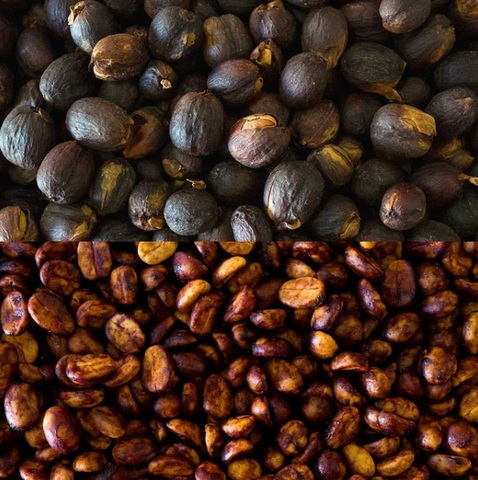What is Honey Processing?
Coffee cherries are picked, sorted, and skin removed. Next, instead of washing off the all the flesh & mucilage like in washed processing, the beans are sent straight to dry instead of waiting to dry it at around 11% moisture content in natural processing.
Laid on drying beds, the beans are raked or agitated every hour till a a designated moisture level. This process uses lasts 6-10 hours for at least 6 days. The mucilage left on the bean after drying is then mechanically removed.
The fermentation period which happens when submerged in water is shortened and the sugar in the bean does not converted to acid. Originating in Costa Rica, this process uses less water which is better for the environment.
 Coffee cherries by Santa Teresa Farm
Coffee cherries by Santa Teresa Farm
Why Honey Processing?
The location of the farm and amount of humidity and rainfall affects the processing choice for the coffee bean. Heavy rain may cause coffee beans to split, which is not favourable for the oxidation of sugar in honey processing, whereas drier weather is preferred as the sugars do not get washed away with the rain.
Refractometers are used to measure sugar content so that the producer can determine if the sugar content level falls under natural process or sugar processed coffee. With more mucilage left on the bean and a longer drying time under shade, it increases the amount of labour and monitoring involved in the 2-3 month harvest to avoid over-fermentation, mold, bacterial infections and loss of freshness which increases defects.
It's a fine line between drying the beans too quickly where the sugar has not infused the bean, and drying it for too long that it becomes moldy.
 Top: Natural Process, Bottom: Honey Process
Top: Natural Process, Bottom: Honey Process
by AgoraCoffeeMerchants
How does Honey Processing affect the flavour of coffee?
No actual honey is added, with the natural sweetness coming from the mucilage. Notes of chocolate, brown sugar, spice and cedarwood come from the mucilage, a sweet & sticky layer which has not been washed off during processing, resulting in a fruity toffee coffee with low acidity. The amount of mucilage left on the bean is controlled to develop varying levels of sweetness and body to the coffee. The more mucilage left on the bean, the sweeter the coffee.
White & Yellow have a cleaner taste which filter coffee drinkers may prefer, whereas the other honeys shine the best in espresso.

Honey Processing by Cafearomasdelcampo
So what are White, Yellow, Gold, Red or Black honeys?
Coffee farms use these colours to differentiate the levels of mucilage left on the bean and resulting sweetness in the cup. Without clear guidelines and allowances in the usage between farms, questions about the exact processing used paint a more accurate picture rather than just identifying coffee by these labels.
| Honey Processing | Processing differences |
| White | Mechanically Washed |
| Yellow | Semi-washed. Approximately 25% mucilage. |
| Black | Highest humidity as dried under shade for longest drying time. Highest concentration of sugar, almost all mucilage. |
| Red | Lower humidity as dried under shade for longer drying time. Approximately 50% Mucilage. |
| Gold | Lowest humidity, Sunny, Warm weather for the fastest drying time |
Interested to try honey processed coffee? We have our Roaster's special Teresa Panama while stocks last, or try our roasted-to-order specialty coffee selection here!
